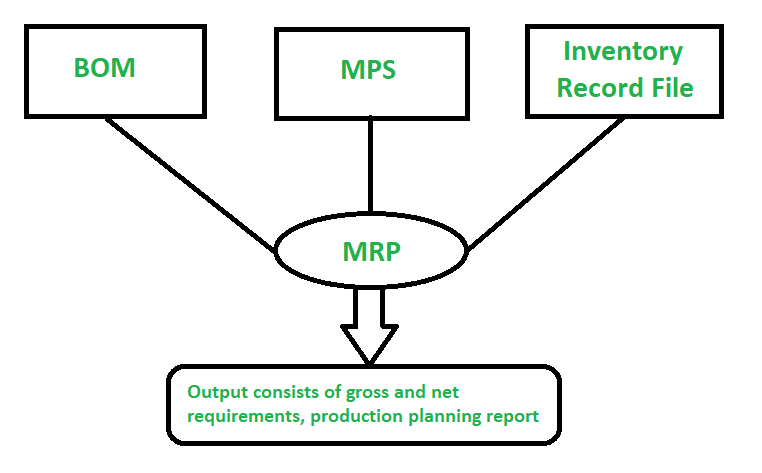主生产计划(MPS)和物料需求计划(MRP)是制造计划系统和库存计划系统的组成部分。这是两个独立的软件系统,它们提供了简化制造过程的方法。需求是任何库存计划系统的关键驱动力,因此首先让这个需求生效,然后我们将了解主生产计划和物料需求计划的区别和使用。
要求 :
需求驱动着任何库存计划和制造系统。
有两种类型的需求,即如下
- 独立需求项:
项目是指直接客户的需求,意味着需求直接来自客户,此类项目也称为顶级项目。这些项目经常具有物料清单(BOM)并被出售。 - 相依需求项目:
需要生产的物料,此类物料也称为“下级物料”。生产所需的原材料和子组件属于相关需求项目。这些物料清单(BOM)。
1.物料需求计划(MRP):
有需求依赖的物料的物料需求计划计划。需要生产物料的MRP计划。它计划我们拥有的材料,需要的材料,期望购买和消费的材料。
下图说明了MRP的工作方式:

物料资源计划
2.主生产计划(MPS):
主生产计划计划有独立需求的项目。 MPS根据客户的直接需求/销售订单和预测计划物料。库存成本,生产成本,产能,工作时间,库存水平,可用存储空间…等在元素生产期间会被考虑。 MPS不会每天运行,而是根据订单和预测周期每周运行一次。
下图说明了MPS的工作方式:

主生产计划
让我们举一个例子,并了解每个的使用场景:
MPS和MRP分开运行只是为了满足变更请求。让我们举一个例子,钢笔是MPS物品,而不同的零件/组件(如瓶盖,笔筒,笔芯等)是MRP物品。 MRP运行得更频繁,以获取生产和维护生产计划所需的操作消息。 MPS不会每天运行,而是每周或更长时间运行,而是通过制造新更改的产品来处理更改请求。
MRP和MPS之间的区别:
| S.No. | MRP | MPS |
|---|---|---|
| 01. | MRP refers to Material Requirements Planning in manufacturing planning systems and inventory planning system. | MPS refers to Master Production Scheduling in manufacturing planning systems and inventory planning system. |
| 02. | It plans items that have dependent demand. | It plans items that have independent demand. |
| 03. | Demand is passed down as the product needs to be produced. | Demand is directly from the customer or forecasts or service orders. |
| 04. | It runs daily to gather idea about required materials and plan accordingly. | It runs on weekly based on sales order/service order and forecasts for that period. |
| 05. | Material Requirements Planning is the planning of critical product. | Master Production Scheduling is the planning of any kind of material. |
| 06. | It runs after MPS. | It runs before MRP. |
| 07. | Material Requirements Planning is used for multi level planning. | Master Production Scheduling is used for single level planning. |
| 08. | Example of MRP items cap, barrel, spring and refill. | Example of MPS item is the pen. |